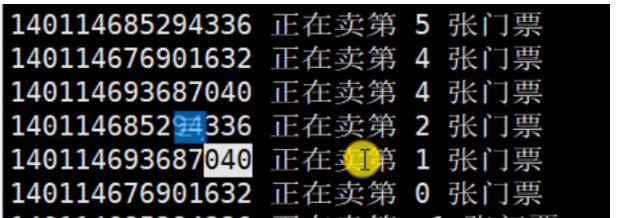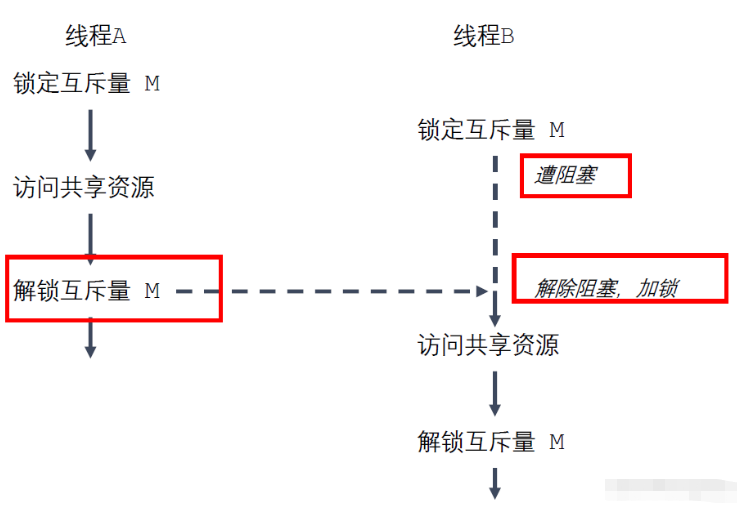您好,登錄后才能下訂單哦!
您好,登錄后才能下訂單哦!
本篇內容介紹了“C++多線程中的線程同步與互斥量實例分析”的有關知識,在實際案例的操作過程中,不少人都會遇到這樣的困境,接下來就讓小編帶領大家學習一下如何處理這些情況吧!希望大家仔細閱讀,能夠學有所成!
/*
使用多線程實現買票的案例。
有3個窗口,一共是100張票。
*/
#include <stdio.h>
#include <pthread.h>
#include <unistd.h>
// 全局變量,所有的線程都共享這一份資源。
int tickets = 100;
void * sellticket(void * arg) {
// 賣票
while(tickets > 0) {
usleep(6000); //微秒
printf("%ld 正在賣第 %d 張門票\n", pthread_self(), tickets);
tickets--;
}
return NULL;
}
int main() {
// 創建3個子線程
pthread_t tid1, tid2, tid3;
pthread_create(&tid1, NULL, sellticket, NULL);
pthread_create(&tid2, NULL, sellticket, NULL);
pthread_create(&tid3, NULL, sellticket, NULL);
// 回收子線程的資源,默認阻塞狀態
pthread_join(tid1, NULL);
pthread_join(tid2, NULL);
pthread_join(tid3, NULL);
// 設置線程分離。
// pthread_detach(tid1);
// pthread_detach(tid2);
// pthread_detach(tid3);
pthread_exit(NULL); // 退出主線程
return 0;
}運行結果:
產生的問題:
每一張票都賣了好幾次;
賣了第0張票和-1張票,都是不對的;
三個線程搶cpu資源。


原因: 休眠的時間,3個進程都進去執行了程序;多個進程對共享資源同時處理,就會產生線程同步問題。
線程的主要優勢: 通過全局變量來共享信息。不過,這種便捷的共享是有代價的:必須確保多個線程不會同時修改同一變量,或者某一線程不會讀取正在由其他線程修改的變量。
臨界區:指訪問某一共享資源的代碼片段,并且這段代碼的執行應為原子操作,也就是同時訪問同一共享資源的其他線程不應終端該片段的執行。
線程同步: 即當有一個線程在對內存進行操作時,其他線程都不可以對這個內存地址進行操作,直到該線程完成操作,其他線程才能對該內存地址進行操作,而其他線程則處于等待狀態。
線程同步會降低線程并發的效率,這是必須的。
為避免線程更新共享變量時出現問題,可以使用互斥量(mutex)來確保同時僅有一個線程可以訪問某項共享資源。可以使用互斥量來保證對任意共享資源的原子訪問。
互斥量有兩種狀態:已鎖定(locked)和未鎖定(unlocked)。
任何時候,至多只有一個線程可以鎖定該互斥量。試圖對已經鎖定的某一互斥量再次加鎖,將可能阻塞線程或者報錯失敗,具體取決于加鎖時使用的方法。
一旦線程鎖定互斥量,隨即成為該互斥量的所有者,只有所有者才能給互斥量解鎖。
一般情況下,對每一共享資源(可能由多個相關變量組成)會使用不同的互斥量,每一線程在訪問同一資源時將采用如下協議:
針對共享資源鎖定互斥量
訪問共享資源
對互斥量解鎖
加鎖是在臨界區對共享數據操作;
如果多個線程試圖執行這一塊代碼(一個臨界區),事實上只有一個線程能夠持有該互斥量(其他線程將遭到阻塞),即同時只有一個線程能夠進入這段代碼區域,如下圖所示:

/*
互斥量的類型 pthread_mutex_t
int pthread_mutex_init(pthread_mutex_t *restrict mutex, const pthread_mutexattr_t *restrict attr);
- 初始化互斥量
- 參數 :
- mutex : 需要初始化的互斥量變量
- attr : 互斥量相關的屬性,NULL
- restrict : C語言的修飾符,被修飾的指針,不能由另外的一個指針進行操作。
pthread_mutex_t *restrict mutex = xxx;
pthread_mutex_t * mutex1 = mutex; --不能這樣操作,有restrict關鍵詞
int pthread_mutex_destroy(pthread_mutex_t *mutex);
- 釋放互斥量的資源
int pthread_mutex_lock(pthread_mutex_t *mutex);
- 加鎖,阻塞的,如果有一個線程加鎖了,那么其他的線程只能阻塞等待
- 成功返回 0
int pthread_mutex_trylock(pthread_mutex_t *mutex);
- 嘗試加鎖,如果加鎖失敗,不會阻塞,會直接返回。
int pthread_mutex_unlock(pthread_mutex_t *mutex);
- 解鎖
*/
#include <stdio.h>
#include <pthread.h>
#include <unistd.h>
// 全局變量,所有的線程都共享這一份資源。
int tickets = 1000;
// 創建一個互斥量 --在全局區創建
pthread_mutex_t mutex;
void * sellticket(void * arg) {
// 賣票
while(1) {
// 加鎖
pthread_mutex_lock(&mutex);
if(tickets > 0) {
usleep(6000);
printf("%ld 正在賣第 %d 張門票\n", pthread_self(), tickets);
tickets--;
}else {
// 解鎖
pthread_mutex_unlock(&mutex);
break;
}
// 解鎖
pthread_mutex_unlock(&mutex);
}
return NULL;
}
int main() {
// 初始化互斥量
pthread_mutex_init(&mutex, NULL);
// 創建3個子線程
pthread_t tid1, tid2, tid3;
pthread_create(&tid1, NULL, sellticket, NULL);
pthread_create(&tid2, NULL, sellticket, NULL);
pthread_create(&tid3, NULL, sellticket, NULL);
// 回收子線程的資源,阻塞
pthread_join(tid1, NULL);
pthread_join(tid2, NULL);
pthread_join(tid3, NULL);
pthread_exit(NULL); // 退出主線程
// 釋放互斥量資源
pthread_mutex_destroy(&mutex);
return 0;
}“C++多線程中的線程同步與互斥量實例分析”的內容就介紹到這里了,感謝大家的閱讀。如果想了解更多行業相關的知識可以關注億速云網站,小編將為大家輸出更多高質量的實用文章!
免責聲明:本站發布的內容(圖片、視頻和文字)以原創、轉載和分享為主,文章觀點不代表本網站立場,如果涉及侵權請聯系站長郵箱:is@yisu.com進行舉報,并提供相關證據,一經查實,將立刻刪除涉嫌侵權內容。